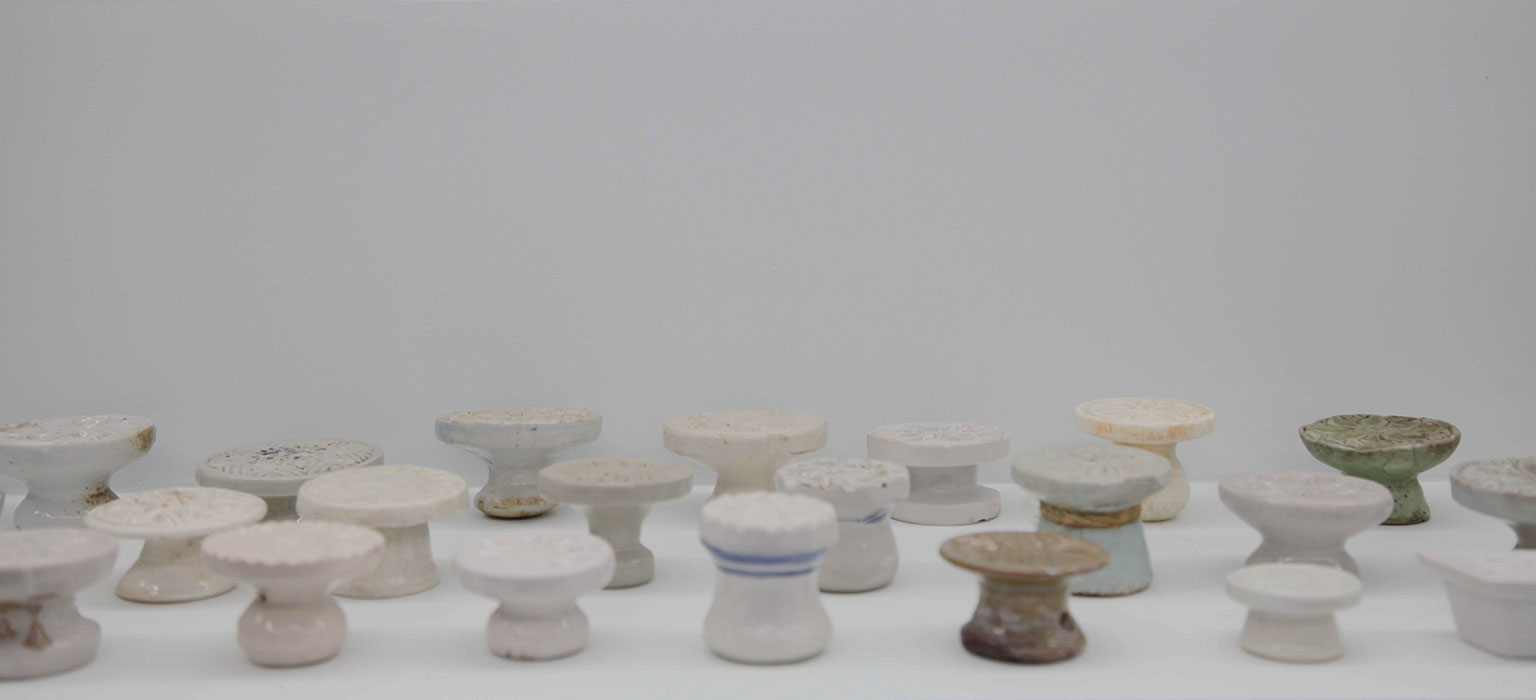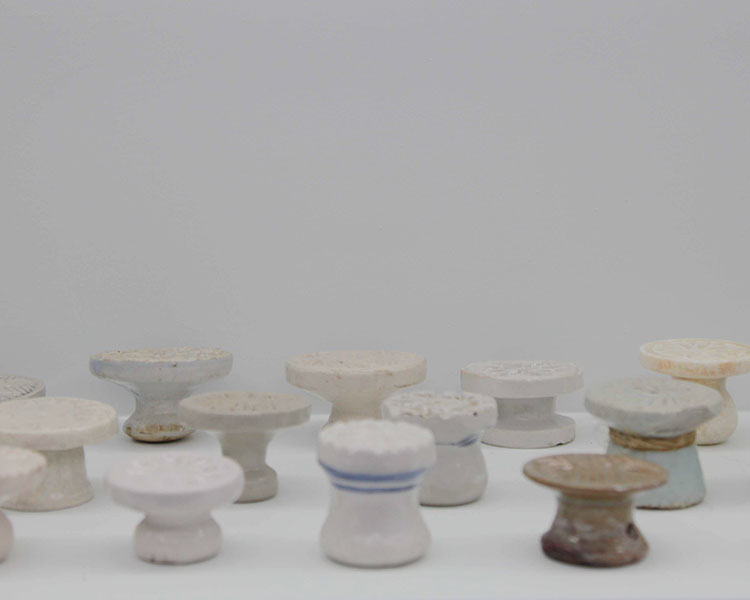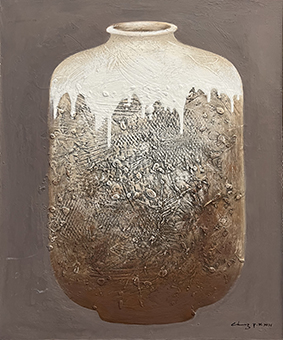

작가 소개
- 송강미술관
- 작가 소개
작가 소개
정봉근(Jeong Bong Geun)
홍익대학교 미술교육원 수료
현재
서양화가
개인전
2005
봉성갤러리개관 15주년 기념-제16회 개인전, 대구 봉성갤러리
부산국제영화제 10주년 기념-제17회 개인전, SEE & SEA 갤러리
제15회 개인전, LA Art Fair
2004
제14회 개인전, SEE&SEA갤러리
제13회 개인전, 마닐라 국립현대미술관
제12회 개인전, 인사아트프라자갤러리
2002
제11회 개인전, 대구문화예술회관
2000
제10회 개인전, 꼬몽트웰시립미술관
개인전, 예술의전당
개인전, 경주 시루갤러리
개인전, 동경 한국중앙회관
개인전, 무역전시관
1999
개인전, 예맥화랑
개인전, 뉴욕 케스트아이론갤러리
1997
개인전, 대구 봉성갤러리
개인전, 조형갤러리
1995
개인전, 갤러리신미술
경력
대구시전 초대작가
1996 구상전 미술공모전 입선
1995 대한민국미술대전 입선(비구상부문)
1994 목우회 미술공모전 입선
작가노트
1990년부터 「古談와 흔적」시리즈를 시작으로 「정지된 시간-化石」시리즈(1992)와 「정지된 시간-도자기」시리즈(2021)로 이어지는 연작을 통해 지구의 역사를 고스란히 담고 있는 화석의 신비를 추상적 회화로 재현하는 원로 서양화가 정봉근
한학자이자 화백이며 서예가인 추전 김화수(秋田 金禾洙)는 그의 작품을 다음과 같이 평가하고 있다. “이번 전시 작품들은 두터운 마티에르의 어두운 흑색을 바탕으로 어탁(魚拓)을 본 것처럼 착각하게 된다. 그리고 콜라쥬나 프롯타쥬를 원용한 것으로도 보인다. 그의 작품들은 포트리에(Foutrier)의 「人質」연작을 환기시키기도 하지만 그 발상과 모티브는 대단히 신선하고 놀랍다. 그가 어떻게, 왜 「물고기 화석」에 착안하여 작품으로 만들어 냈느냐에 그 결과로서 나타난 것은 신비롭다. 그러나 여기에는 작가의 세심하고 조심스런 의도와 남모를 노력 등 고심의 흔적이 베어 있다. 자세히 보면 명암의 대조로 물고기나 식물의 형상을 그려내고 있으며 가급적 붓과 나이프의 흔적을 배제하여 자연스럽게 보이도록 화면을 이끌고 있다.
작가가 구사하는 붓자국(Brush Work)과 얼룩, 반점의 흔적, 두터운 마티에르 등은 탓시즘(Tachism), 또는 앵포르멜의 표현기법이기도 하며 이미 세계적으로 유형화되어 보편적인 양상을 띄고 확산되고 있는 것이다. 그의 작품 속 표면은 유화물감의 기름기가 제거되고 건삽한 느낌을 준다. 표면이 그러할 뿐 아니라 색채 역시 거의 무채색조로 검정색, 청재색, 회갈색, 모래색 등으로 화석이 지닌 실체감 조성에 부합된다. 화석의 질감 효과를 나타내기 위하여 아크릴 등 혼합재료로 작품이 만들어진다. 그 결과로서 나타나는 것은 고대 고분벽화에서처럼 우현하고 퇴락한 분위기와 신비로움이다. 그가 구사하는 색채는 가야나 신라 토기가 갖고 있는 색과 질감을 재현해 놓은 듯하다.
이러한 정황에서 그려진 그림의 첫 느낌은 「우리의 것」이라고나 할 것으로-서양화에서 느끼는 위화감이 전혀 없다. 이점은 정봉근이 이룩한 하나의 성과이기도 하다. 그의 그림들은 한국화·서양화로 분류한다면 한국화로 불릴 성질의 것이며, 실로 「신토불이」에 딱 부합된다. 구상에서 추상으로 전향한 작가가 우리 토양에 맞는 추상화의 한 전형을 만들어 냄으로써 가지는 의미는 실로 가볍지 않을 것이다.
보는 사람들로 하여금 여러 가지 환상으로 이끄는 그림들의 해석 또한 흥미로울 것이다. 억만 년의 시간을 지하에 묻혔다가 지상으로 나와서 사람들의 눈에 보이는 화석은 그 자체만으로도 신비로움과 꿈과 기억을 환기하는 힘을 가졌다.
화합하고 타협하려는 시대적 배경이 무언 속에 강한 힘을 주고 있어 이를 보는 이로 하여금 의식과 무의식 속에 나도 한번 그의 작품 속에 합류하고픈 충동을 일으키기도 한다.”
그의 작품은 흡사 화석을 탁본한 듯 단색조 이미지의 강한 인상을 주고 있지만 이는 화석을 차용에서 오는 시간성의 표상이다. 지질시대 퇴적암 속에 퇴적된 동식물의 형태는 과거와 현재를 구분 짓는 시각적 요소로 의미를 더해 주고 있다. 화석 속 달 항아리 형상은 구상적 이미지를 극복해 추상적 에너지로 전환함으로써 신선한 시각적 충격을 안겨 주는 조형적 발상의 전환인 셈이다.
Beginning in 990 with the series "Old Stories and Traces" and continuing with the series "Frozen Time - Fossils" (1992) and "Frozen Time - Ceramics" (2021), the elderly Western artist recreates the mystery of fossils, which contain the history of the earth, in abstract paintings.
Korean scholar, painter, and calligrapher Chuzhen Kim Hwa-soo (秋田 金禾洙) commented on his work. "The works in this exhibition are based on the dark black color of thick matieres, which gives the illusion of looking at a fishbowl. They also seem to have been inspired by collage and pâtissage. His works are reminiscent of Foutrier's "Human Quality" series, but the ideas and motifs are very fresh and surprising. It is a mystery as to how and why he came up with the idea of "fish fossils" and turned it into a work, but it bears the traces of the artist's meticulous and careful intentions and efforts to improve his appearance. If you look closely, you can see that the artist has drawn the shapes of fish and plants with contrasting colors, and as much as possible, he has excluded the traces of brushes and knives, leading the picture to look natural.
The artist's brushwork, smudges, spots, and thick matieres are also expressive techniques of Tachism, or en plein air, which has already been typified and spread worldwide. The surfaces of his works are de-oiled and rough, like oil paintings. Not only the surface, but also the colors are almost neutral, with black, blue-ash, gray-brown, and sandy hues that match the tangibility of fossils. To achieve the textured effect of fossils, the works are created with mixed media such as acrylics. The result is a sense of mystery and decadence, as in ancient tomb paintings. The colors he uses seem to recreate the colors and textures of Gaya and Silla earthenware.
Under these circumstances, the first impression of the paintings is that they are "ours"-there is no sense of incongruity with Western paintings. This is also one of Jung's achievements. His paintings are of a nature that would be called Korean painting if they were categorized as Korean or Western painting, and they are indeed in line with "Shinto Buddhism." The significance of the artist's transition from figuration to abstraction is that he has created a type of abstraction suited to our soil.
It will be interesting to see the interpretation of the paintings that lead the viewer to various fantasies. A fossil buried underground for hundreds of millions of years and then brought to the surface to be seen by humans has the power to evoke mystery, dreams, and memories in its own right.
The background of the era of harmony and compromise has a strong force in it, which makes the viewer consciously and unconsciously feel the urge to join in the work."
His works have the strong impression of monochromatic images that resemble fossils, but this is a representation of temporality that comes from borrowing from fossils. The forms of plants and animals deposited in the sedimentary rocks of geologic periods add meaning as visual elements that separate the past from the present. The shape of the moon jar in the fossil is a shift in sculptural idea that overcomes the figurative image and converts it into abstract energy, bringing a fresh visual impact.




